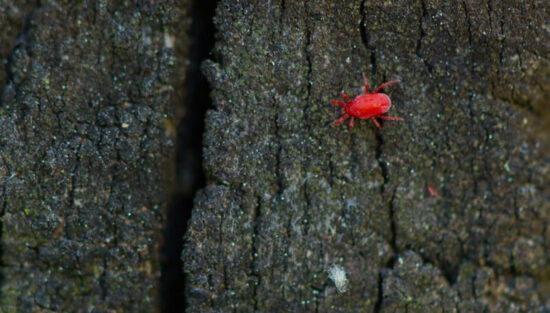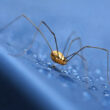Getting rid of clover mites can be surprisingly difficult if you don’t know where to start. These tiny bugs are hard to spot and can access just about anywhere!
This guide will teach you how to get rid of clover mites. We cover many different methods to give you plenty of options when it comes time for you to deal with them on your own.
Table of contents
What Are Clover Mites?
Clover mites are tiny bugs that often go unnoticed until populations start flourishing. Measuring less than a millimeter wide, these bugs are difficult to spot unless you have some magnifying equipment and a keen eye. They’re masters of evasion and usually don’t pose a problem to homeowners.
That said, growing numbers can lead to full-blown infestations that wreak havoc on your garden and lawn, which means you need to get rid of them.
Clover mites occur naturally throughout the United States and go by many different names. You might hear people calling them concrete mites, red velvet mites, spider mites, and even rain bugs. Whatever you call them, these bugs have a few distinct characteristics.
The most defining physical attribute is their color. Clover mites take on a fiery hue that ranges from bright red to rusty reddish-brown. That color is pretty saturated, which is evident the moment you accidentally crush one.
A crushed clover mite leaves behind red pigment, which can be a hassle to remove. It’s most prevalent on sidewalks and concrete surfaces, which is how they get the nickname of “concrete mite.” However, you’ll also see that color smear on carpets and tiles inside.
Quick Tip: Contrary to popular belief, the red staining is not blood. Instead, it’s simply pigmentation from the pest’s body.
Beyond the red color, clover mites have several tiny legs. Technically, these insects are part of the arachnid family! They have eight legs, which they use to crawl onto plants and scurry to safety in the face of trouble.
Clover mites can appear throughout the year, but they are most prevalent in the early spring and late fall. They thrive in cooler climates, so populations tend to thrive as temperatures drop.
What Attracts Them?
Like any other pest, clover mites are drawn to places that provide shelter and easy access to food. That means if you want to learn how to get rid of clover mites (more on that later), you’ll need to understand their basic needs.
In the case of a clover mite, it’s not the safety of your home that they find appealing. They’re attracted to the abundance of food in your lawn and garden! Clover mites exclusively feed on the nutrients that plants provide. They suck the nutrition out of plant juices.
These pests love over-fertilized lawns with thick and healthy grass. You can also find them living on shrubbery and any other form of vegetation you might find around your property.
Quick Tip: Typically, the first sign of an infestation is a patchy lawn. Clover mites will migrate to grassy areas with soft sand to build their nests. Once established, they use the nearby grass to flourish and grow their numbers.
If you happen to spot some clover mites in your home, they likely got there through small gaps in your windows or doors. Thanks to their tiny size, the mites can crawl through just about anything.
Finding clover mites inside the house isn’t very common, as they prefer to live near plants. Usually, homeowners with mite problems have many houseplants. In many cases, they’ll start by feeding on plants living on windowsills or planter boxes hung just outside the window.
Then, they’ll move inside when things get too hot. When this occurs, the bugs will typically move to the attic or any other warm room. You may even see them on patios, rooftops, or rooms with leaks. While they prefer to eat healthy plants, they resort to algae and mold if nothing else is available.
How To Get Rid Of Clover Mites
Clover mites aren’t dangerous, but that doesn’t mean that their presence is welcome. These bugs can leave behind a wake of mess and impact the overall health of your plants.
Fortunately, there are several ways to get rid of clover mites. Here are some of the most effective methods to consider.
1. Vacuum Them Up
Here’s an easy way to get rid of clover mites in your house. Clover mites can be difficult to see because of their small size. But when you have a white carpet, that signature red color tends to stand out!
The last thing you want to do is let those bugs have free reign in your home. Even if they die off slowly due to a lack of food, the stains they leave behind when crushed can ruin your floors.
When you spot the mites scurrying around, vacuum them up! Use a powerful vacuum to remove the bugs from your floors without killing them directly. They may die in the machine, but the staining won’t cause too much of an issue there.
Quick Tip: If possible, use a bagged vacuum with a HEPA filter for the best results. The bag will make disposal a breeze while the filter ensures that the bugs don’t become airborne and trigger any allergies.
2. Place Sticky Traps
Sticky tape is a surprisingly effective way to get rid of clover mites.
These bugs cannot fly or jump. They have no choice but to crawl over surfaces to access food and shelter. Why not use that fact to your advantage?
Sticky traps are affordable and readily available at most garden stores. Pick up some traps and place them strategically around your home to prevent mites from getting in.
Try putting some traps around windows and door gaps. That way, you’ll catch the clover mites before they have a chance to get inside and start laying eggs!
3. Spray Vinegar & Water
Vinegar is an excellent catch-all solution that works to repel and kill many different kinds of insects. You’ll be happy to know that vinegar is an effective clover mite killer (it works on contact).
Create a solution of equal parts white vinegar and water. Pour it into a spray bottle and apply it directly to mites as you see them.
Quick Tip: To be on the safe side, do a little spot testing to ensure that the solution won’t cause harm on any surface in your home. Even when diluted with water, vinegar is acidic enough to damage some surfaces. So make sure to test things first!
Once you know that the spray solution won’t cause trouble, you can use it anywhere. Many homeowners like to spray it on the lawn as well! The vinegar is all-natural and is a great way to kill or get rid of any clover mites that are hiding in the grass.
4. Spread Diatomaceous Earth
Here’s another must-have product that will help you get rid of clover mites naturally.
Diatomaceous earth is a powdered substance that slowly dehydrates and kills bugs. It works on everything from clover mites to aphids. It’s safe on plants, so you’re free to scatter it throughout your lawn and garden.
Best of all, diatomaceous earth is super affordable. You can pick up a bag at your local garden center for only a few bucks! It’s undoubtedly a worthy investment that can make a world of difference.
Sprinkle the powder in known problem areas. You can also use it as a barrier around the perimeter of your home. The clover mites are doomed the moment they walk on the powder.
5. Use Soapy Water
Believe it or not, something as simple as soapy water can do the trick.
Clover mites aren’t the most resilient creatures around. However, they have ample protection from the elements. Soapy water can change all that.
Soap kills soft-bodied bugs like the clover mite by dissolving its protective cuticle. Once that’s out of the way, the bug is prone to injury and dehydration. The mixture can then suffocate the insect, resulting in death after only a few short minutes.
Quick Tip: Like the vinegar solution we mentioned earlier, make sure to dilute the soap. Add only a couple of drops to clean water, give the bottle a good shake, and you’re ready to go!
Spray the clover mites as you see them and gently remove them with a towel. Make sure to be extra gentle and avoid crushing the bugs.
6. Try Boric Acid
Boric acid is another popular ingredient that homeowners can use to tackle many different kinds of bug infestations. Often found in the laundry section, the powder is relatively safe and easy on the wallet. This clover mite treatment is unique compared to what it does to roaches and ants.
The goal here isn’t to slowly poison or kill clover mites. It’s to deter them.
Clover mites are cunning and will avoid boric acid at all costs. If they are brave enough to walk on it or consume it, they’ll quickly die.
Sprinkle the powder around common areas where you’ve seen the mites. You can also apply it around your home and near gardens. It’ll act as an invisible barrier, preventing the mites from crossing.
Quick Tip: Make sure to reapply the boric acid regularly if used outside. The powder will wash away with rain.
7. Sprinkle Some Baby Powder
Baby powder serves the same purpose as boric acid. It gets rid of clover mites by deterring and preventing them from entering a room.
The talc-based powder is easy to use. All you have to do is apply it evenly across your floors. Pay close attention to corners, as the bugs can easily use those forgotten spots to get around the powder.
If the clover mites affect specific areas or furniture pieces, use the baby powder to drive them away!
Make sure to keep people and pets out of the area as long as possible. You can then go back with a vacuum to pick up dead bugs. Alternatively, you might want to repeat the application to ensure that the bugs don’t return.
8. Don’t Overwater Your Plants
Finally, pay attention to how often you’re watering plants. You must avoid overwatering outdoor and indoor plants.
Too much water will result in stagnation and weathering. The soil becomes super soft, paving the way for clover mites to move in. They prefer soft and slightly eroded soil because it’s easier to form a nest.
By managing how much water you provide, you can maintain soil integrity and make the area unappealing to clover mites. Some homeowners have seen success reducing watering sessions temporarily. You can try that technique if you have resilient plants that do well without water for a few days.
It’s not a suitable long-term method, but some dryness can help get rid of clover mites that are currently living in the soil.
Ways To Prevent Them From Coming Back
After you successfully get rid of the existing clover mite infestation, you can start thinking about ways to keep these bugs out. Clover mites can always return if conditions go back to the way they were. Keeping the pests out is about adopting long-term preventative measures.
Start by keeping your house and property clean. Focus on vegetation around your home.
Trim back bushes and uproot weeds that pop up during the spring and summer seasons. Prevent overgrowth, as an abundance of plants will only attract the mites closer. Trim back trees, keep your grass short, and pick up any yard debris as it falls.
As for your grass-covered lawn, avoid overfertilization. It’s easy to go overboard with fertilizers when you’re trying to maintain green landscaping. Realistically, you shouldn’t need to feed your grass more than a couple of times per year!
You might not even have to fertilize at all if you receive plenty of rain. Scale back and work with a landscaper if necessary to ensure that you’re not overdoing things.
If you want to have some extra peace of mind, consider taking measures to prevent clover mites from entering your home.
One option worth considering is creating a plantless border around your home. Remove any grass and plants about two feet out from your home’s exterior walls. Replace the dirt with dry soil, coarse sand, or landscaping rocks.
Doing so will ensure that clover mites can’t nest or get anywhere near your home! Of course, you can also seal up cracks, apply weatherstripping to windows and doors, and close up any potential access points.
With these techniques, you should keep the clover mite population under control and prevent any future infestations.
Are They Dangerous?
If you’re worried about how clover mites might affect your health and the health of those around you, don’t worry. These bugs pose no significant health risks.
They don’t bite you like chiggers and other mites. Not only that, but clover mites aren’t known to transmit diseases to humans or pets.
The worst thing you’ll have to worry about with clover mites is red staining. As we mentioned earlier, the bodies leave behind some stubborn pigmentation when crushed. Beyond that, these pests are nothing more than a nuisance inside the home.
Can They Hurt Your Lawn & Garden?
While they don’t pose any health risks to humans or animals, clover mites do have the potential to cause some trouble in your lawn and garden! These bugs feed on plants to survive. Luckily, their impact isn’t as massive as aphids and other garden pests.
Typically, a small nest of clover mites isn’t going to do much noticeable damage to plants.
That said, issues can arise when clover mite populations get out of hand. Once thousands of tiny bugs start feeding on your plants, they will suffer. This is usually what makes homeowners want to get rid of clover mites in the first place.
You’re most likely to notice the problem on your lawn first. Clover mites create nests in soft soil and feed on surrounding grass. The grass may experience stunted growth or discoloration, resulting in noticeably bare patches around the yard.
Quick Tip: If the bugs attack a nearby shrug or garden plant, the effects will creep up the more they feed. At first, the plant may look slightly yellow and discolored. Eventually, those problems will graduate to wilting and slow growth.
It’s important to stay on top of clover mite populations. Small nests won’t cause much trouble, but these bugs can take over if you’re not vigilant.
Vegetation They Prefer
Clover mites feed on a wide variety of plants.
They’re most drawn to fragrant plants like clovers. They also like to suck the nutrients out of flowers and herbs. Ornamental plants, shrubs, weeds, and more are on the table, too.
Many homeowners see clover mite populations boom if they accidentally over fertilize their lawn. Fertilization results in abundant growth, which ends up creating more nutrients for the bugs to consume. Overfertilization, as well as over-watering, are surefire ways to draw these bugs in.
Even if you don’t have a ton of traditional vegetation, clover mites will find things to eat. They’ll feed on algae, mildew, fungi, and even compost. Any form of plant-based organic matter will do.
Where To Find Their Eggs
Clover mites reproduce pretty quickly, which is why infestations can become a massive problem for homeowners. When working to get rid of clover mites, you’ll need to take their eggs into account.
Once they reach maturity, female mites will lay upwards of 70 eggs during the summer and fall seasons. They usually deposit the eggs in well-protected places that get plenty of exposure to the sun.
Eggs can lay dormant during the summer or even overwinter during the colder months. Where the mite lays the eggs is crucial for their survival.
You can find them within small cracks in foundation walls, concrete slabs, or fence posts. Clover mites also like to lay eggs under tree bark or any other natural surface that’s well-hidden.
Once the eggs hatch, the nymphs will get to eating plant material almost immediately. Depending on the environment, they may grow and mature within 30 days.
Closing Thoughts
Now that you know how to get rid of clover mites, the entire process should be fairly simple. It doesn’t matter how big the infestation is (or if you decide to get rid of them naturally or not), these little insects are quite predictable.
If you have any questions, we’re always here to help. Simply send us a message through our contact page and we’ll respond as soon as we can!


